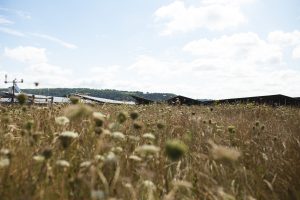Our promise to land, people, and planet
Biodiversity is the foundation of healthy ecosystems. Managing the environment in a sensitive way helps ensure clean water, fertile soils, and protection for the pollinators that sustain our food supplies. Yet too often, development comes at nature’s expense.
At British Solar Renewables, we’re proving it doesn’t have to. Our solar farms are multi-functional landscapes that unite clean energy generation, support agriculture and allow habitats to thrive.
By combining renewable power with responsible land management, we help increase biodiversity, improve soil structure, and support resilient ecosystems that benefit both people and planet.
The Nature Protection Pledge sets a higher standard for how we develop and manage land, ensuring every site delivers measurable environmental gain, supports local communities, and leaves the land richer than we found it.
Nature Protection Pledge commitments
- Manage the land in an environmentally sensitive way tailored to the specific landscape and its species.
- Encourage a mosaic of habitats on our sites, optimising them for biodiversity.
- Achieve a proposed combined 60% biodiversity net gain (“BNG”) for each solar project submitted to planning, calculated as follows: Habitat units % + Hedgerow units % + River units % => 60%
- Enhance any ponds on the site by clearing excess vegetation and shading, and removing rubbish.
- Use buffers to protect high-biodiversity areas, such as ancient woodlands, tree roots, ponds, and wetlands.
- Create gaps in fences to promote wildlife corridors for small and medium mammals
- Undertake soil type tests and plant appropriate wildflowers and grasses. Use locally sourced wildflower seeds where possible and plant seeds of nectar-rich species to encourage pollinators.
- Protect ancient and veteran trees, plant only UK-grown native species and enhance native hedgerows to create green corridors for wildlife.
- Only use de-ionised water to clean panels.
- Collaborate with local biodiversity action/ wildlife groups and organisations such as the Bumblebee Conservation Trust, to enhance and protect local species.
- Continuously explore opportunities beyond planning requirements to achieve ecological enhancements appropriate to the local environment.
- Install bird boxes appropriate to the local species. Aim to encourage any local Birds of Conservation Concern with targeted projects.
- Install bat boxes on mature trees, tailored to the species present on the site.
- Install hibernacula for reptiles, invertebrates, amphibians and small mammals using recycled and foraged materials, along with bug hotels.
- Monitor the biodiversity on the site through annual surveys and ad-hoc biodiversity inspection sheets for each visit.
- Approach end-of-life decommissioning in a way that benefits the environment, soil structure and biodiversity.
- Display site credentials and biodiversity information for the solar park for visitors and communities.
Creating spaces where nature thrives
We’ve partnered with the Bumblebee Conservation Trust to create and protect habitats for pollinators, including the rare Shrill Carder bee, one of the UK’s most threatened species.
Across our solar parks, we’re planting tailored wildflower mixes and managing grassland specifically for bees and invertebrates, helping to reverse population decline and create thriving ecosystems around our sites.
At Aller Langport, for example, we’ve safeguarded an active badger sett with protective fencing, added new hedgerows, and planted visual screening that supports wildlife corridors and local biodiversity throughout the life of the park.
This work is supported by our investment partner ICG, whose commitment to strong ESG principles aligns closely with our own. Together, we’re proving that clean energy projects can be catalysts for environmental regeneration.
Tracking change for the long term
Through our voluntary bat survey programme, our team monitors bat populations across multiple solar parks each year. These ongoing studies help us understand how our projects influence local ecosystems and how habitat creation benefits species diversity over time.
Even where surveys weren’t required by planning consent, we’ve carried them out voluntarily, building a consistent dataset that supports national bat conservation efforts. So far, we’ve recorded species including Alcathoe, Barbastelle, and Common Pipistrelle, all thriving in landscapes designed for coexistence between energy and nature.
Can other renewable energy companies follow the Nature Protection Pledge?
Protecting nature should be at the heart of renewable energy, not an afterthought. As one of the UK’s leading renewable energy developers, we believe this responsibility belongs to all of us.
Our Nature Protection Pledge is more than a commitment from us; it’s a framework that any responsible renewable energy developer can follow. It’s designed to help our industry take shared accountability for protecting land, wildlife, and communities alongside clean power generation.
The pledge is our way of showing that we not only understand the importance of enhancing the land and its ecosystems, but also recognise our duty as a renewable energy business to make a lasting, positive impact. It holds us accountable and offers others a practical guide to do the same.
We call on developers across the renewable energy industry to join us in setting a higher standard for sustainable energy, one that powers progress and protects nature for generations to come.
